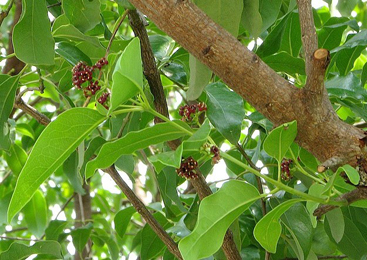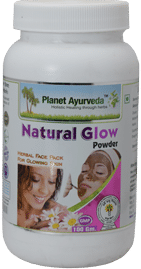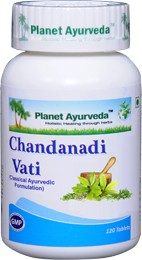Chandan (Santalum Album) - Medicinal Properties, Benefits, Dosage

Description of the Plant
Chandan is known as one of the oldest and precious plant with great fragrance. The scientific name of the plant is Santalum album. This belongs to the family Santalaceae. Chandan plant is an ever green plant that can grow up to 20 m attain girth up to 2.4 m wide with branches which are drooping and slender. The bark of the tree can be of dark brown color, red color, dark grey or of black color in the young plants. In the older plants, these barks are with deep cracks and of red color from inside. The sapwood of the stems is white in color and odorless. On the other hand, heartwood is of yellow brown color with strong fragrance. Leaves of the Chandan are ovate elliptical shaped, 3 to 8 cm long and 3 to 5 cm wide, usually present oppositely and have shiny green appearance from the upper side. These are glabrous and glaucous. The tips of the leaves can be either pointed or rounded. Its stalk is grooved and long up to 5 to 15 cm. flowers of the Chandan plant are of purple brown color and small in shape. The straw of the flowers are of red, green or violet color. These are 4 to 6 mm long with 6 terminal or axillary, unscented clusters of peniculate cymes. Its fruits are fleshy indehiscent, globose, purple to black in color, about 1 cm in diameter when ripe. These have a hard endocarp and scar which are smooth, stalk less and single seeded.
There are two main varieties of sandalwood, one is Indian and other is Australian. In Indian one, Flowers flourish in the months of March and April. The fruits ripe in the cold season. In Australian, flowers flourish in December and January. Fruits appear in June to September. This plant requires approximately 20 to 25 inches rainfall every year and cannot tolerate water logging.
General Description
Chandan word is derives from Sanskrit and Persian (chandan). Generally it is known as White sandalwood, Safed Chandan and Srigandha.
This plant has a great reference found in Indian mythology, scripture and folklore. It is found in literatures like Arthashastra (200 BC), Patanjali Mahabhasaya (100 BC), Vinaya Pitaka (400-300 BC), Milinda Pahna (200 BC), Anguttara, Kautilya and Dhamma. It is also known to be mentioned in the holy books Ramayana and Mahabharata.
Chandan and its essential oil derived from its heartwood has been used to treat various ailments. The scent of the essential oil of Chandan calms the mind, nervous system, and mood thus awakens and enliven intelligence, courage, strength and happiness. This is also used for medicinal purpose as it has sedative, aromatic, diuretic, diaphoretic, disinfectant, aphrodisiac, cardio tonic, expectorant, haemostatic and antipyretic properties which can help to treat problems like acidity, gonorrhea, bronchial and skin ailments.
This plant do all these activities with the help of phytochemicals present inside the plant parts. The main chemical constituent of essential oil is santalola which is composed of C15H24O. It has hydrocarbons like santene, nortricyclo-ekasantalene, aldehydes like nor-tricyclo-kasantalal 3,7,8 and the acids α-and β- santalic acids and alcohols like santenol, α-santalol, beta-santalol, teresantalol and more. The leave wax contain hydropalmitone and palmitone.
Classification
- Kingdom - Plantae
- Subkingdom - Tracheobionta
- Superdivision - Spermatophyta
- Division - Magnoliophyta
- Class - Magnoliopsida
- Subclass - Rosidae
- Order - Santalales
- Family - Santalaceae
- Genus - Santalum
Habitat
Chandan is found in countries like India, Indonesia, Australia and New Zealand. These flourish well from the sea level up to 1800 m in sandy, lateritic and loamy soil. Trees found on stony hills have high content of scent in their woods.
In India, it is found mainly in Karnataka and Tamil Nadu. In Tamil Nadu, it distributed over 3000 sq. kms in Javadis hills, Chitteri hills and Yelagri hills. It is also found in states like Orissa, Rajasthan, Uttar Pradesh, Bihar, Andhra Pradesh, Kerala, Maharashtra, Madhya Pradesh and Manipur.
Names of the Chandan
- Sanskrit name - Chandan, Malayaja, Malayaja, Gosheersha, Tilaparnaka Shreekhanda, Chandradyuti.
- Hindi Name - Safed chandan, chandan, sandal
- English name - White Indian sandalwood, sandalwood, sandal, sandal tree, East Indian sandalwood
- Malayalam Name - Candanam
- Bengali Name - Chandan, peetchandan, srikhanda
- Tamil Name - Chandanm, Sandanam
- Telugu Name - Tella Chandanm
- Gujarati Name - Sukhada, sukhet
- Punjabi name - chandan
- Kannada name - shrigandha, chand
- French - Santal blanc
- German - Weisser Sandel
- Italian - Sandalo bianco
- Indonesian - Chandan, chendana, cendana
- Burmese - Santagu
- Spanish - Sandalo blanco
Ayurvedic Properties
| Hindi / Sanskrit | English | ||
| Rasa | Madhura, Tikta | Taste | Sweet, Bitter |
| Guna | Laghu, Rooksha | Physical Property | Light, Dry |
| Virya | Sheeta | Potency | Cold |
| Vipaka | Katu | Metabolic Property (After Digestion) | Pungent |
Classical Categorization
It helps to control and manage the kapha and pitta doshas.
| Charak Samhita | Vagbhata | Sushrut Samhita |
|
|
|
Ancient Verse about Chandan

The Bhavprakash nighantu, Edition of 1998, verse11 to 13, page no. 186 - 187.
It states that it is known with the names of Srikhanda, chandan, madhrashri, Tilaparnaka, Gandhasara, Malayaja and Chandradyuti.
Best Chandan is white in color, bitter in taste, after being rubbed gives yellow color and if it broken in pieces gives red color. It appears white from the outside. It is considered as best if it is rough in texture.
This has properties like cold potency, dry and light nature, pacifies pitta in the body, it manages fatigue, weakness, thirst, heat and blood impurities.
References
The Bhavprakash nighantu with elaborated Hindi commentary by Padmashri prof. K.C. Chunekar, edited by Dr. G.S. Pandey: Edition of 1998, verse11 to 13, page no. 186 - 187.
Practical Uses of Chandan
- The leaves extract of the plant tends to decrease the levels of bilirubin and increases the level of dismutase, catalase and glutathione, hence help to remove toxins from liver.
- This shows effect on nerves, act as nerve relaxant and cure problems like headaches, insomnia and nervous tension.
- It is also helpful in treating gastric ulcers as it inhibits Local Irritants and Drugs like NSAIDs.
- This plant shows anti-bacterial activity against various bacteria like Helicobacter pylori, Staphylococcus aureus, Herpes simplex virus Type 1 and resistant Candida species.
- The component a-santalol shows anticancer ativity as it is helpful in skin cancer, leukemia, prostate cancer and more.
- It shows antioxidant properties as on regulatory effect on nitric oxide (NO) levels.
- This also shows antiviral activity as it combats Herpes simplex viruses (HSV)-1 & 2 and virus induced skin problems.
- The methanol extracts of the plants shows great anti-inflammatory activities.
- It acts as aphrodisiac and used to treat Spermatorrhoea.
- The paste made from this can help to improve the skin complexion, stop burning sensation and clears wounds.
Parts Used
- Bark
- Chandan essential oil
Dosage
- Powder - 3 to 4 grams
- Oil - 5 to 10 drops
Ayurvedic Products that Use this Herb by Planet Ayurveda
Natural Glow Powder
Natural Glow powder is a 100% pure product taken from the best quality Ayurvedic herbs that are blended together and made into powder form. These Ayurvedic herbs are in use since ages for the wonderful effects they show on the skin. Herbs used in the Natural Glow powder are Multani mitti, Cucumber seeds, Chandan, Haridra, and orange peel. All of these have been individually used since ages for the curative and healthy effects on skin. We have taken the best of these to form a single multi-effect herbal powder.
Chandanadi Vati
Chandanadi Vati is commonly known as the Indian sandalwood. It is the herb of choice in a variety of diseases like Diabetes, Renal diseases like Nephritis, Nephrotic syndrome, urinary problems like urinary tract infections, dysuria, burning micturition, vaginal infections etc. It balances the vitiated Pitta (Fire and Air element) and kapha (Water and Earth element) doshas.





